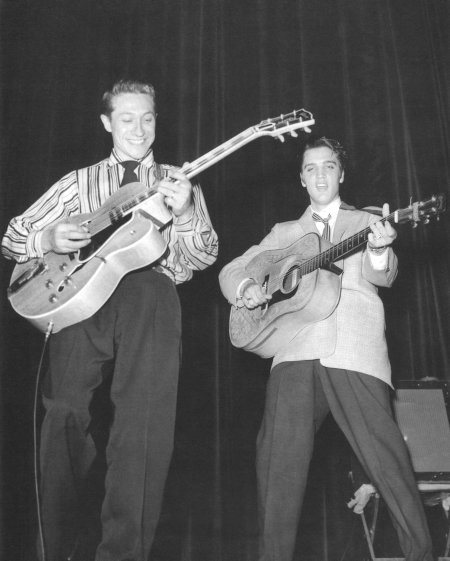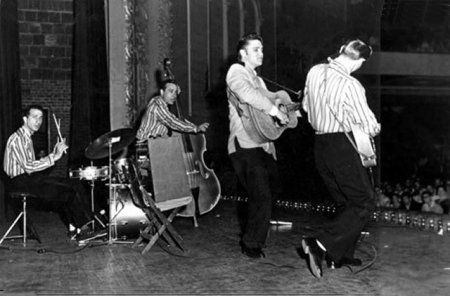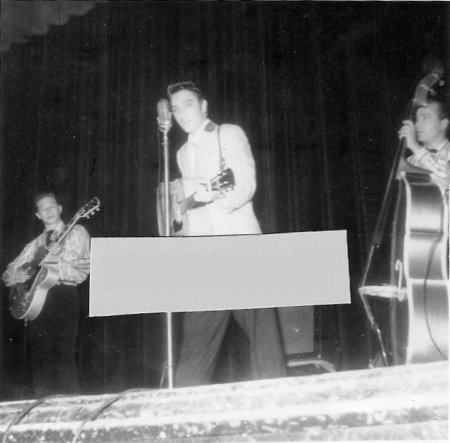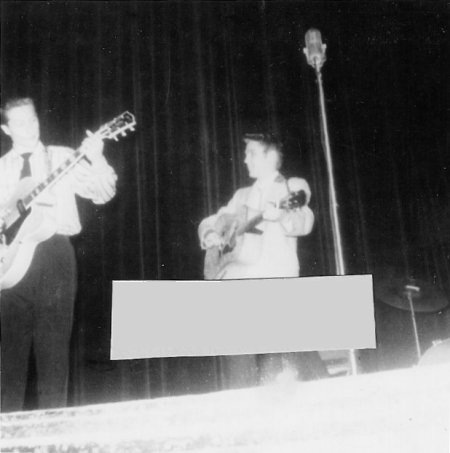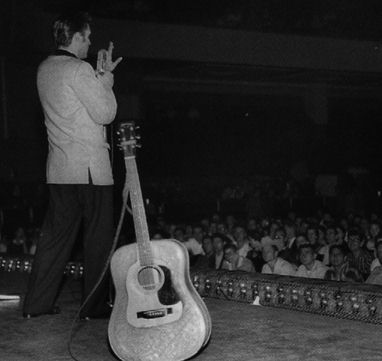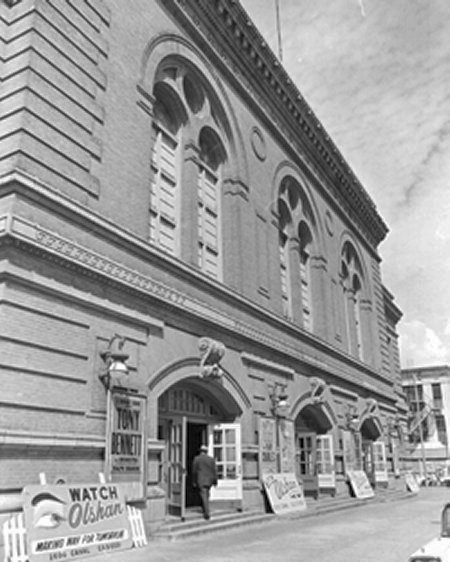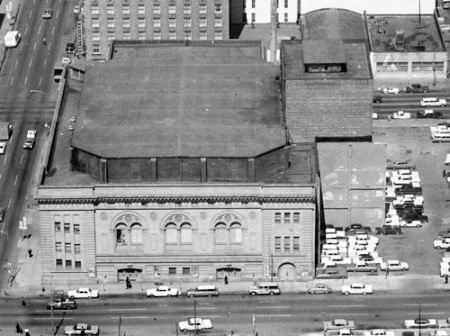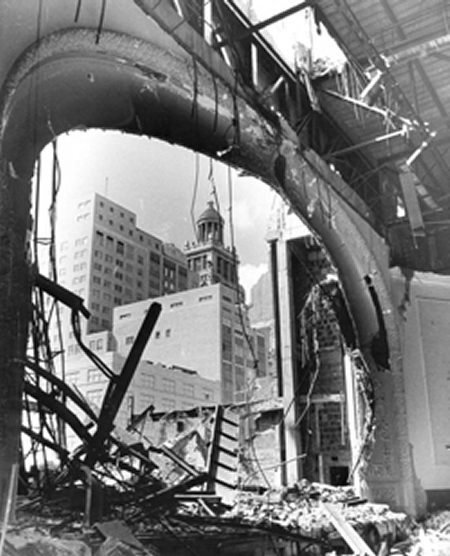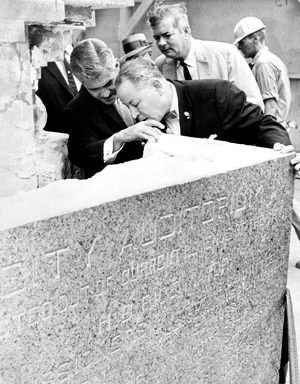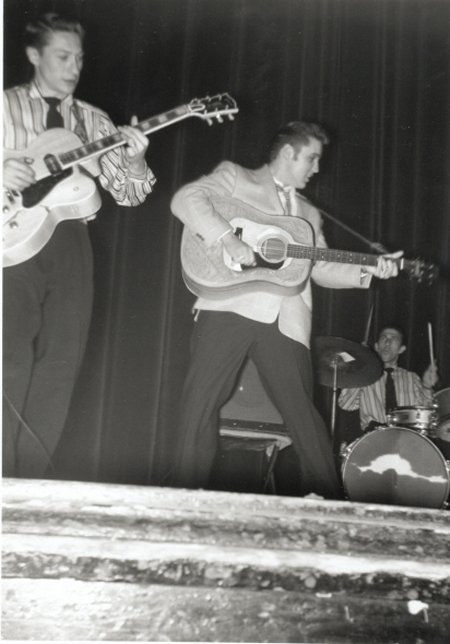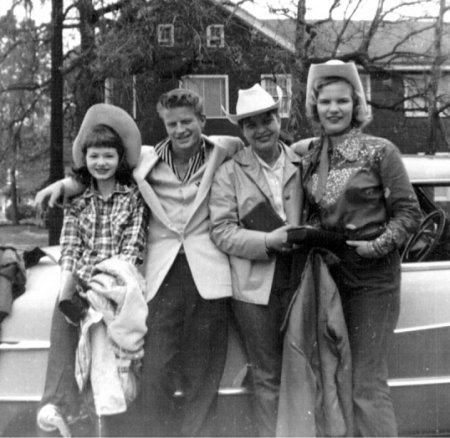 |
City Auditorium - Houston, TX The Winnie Davis Auditorium in Houston had been opened in 1895. The hall, located at the corner of Main and McGowen and named after the daughter of the former Confederate president, Jefferson Davis, sported electrical connections, but the plumbing was primitive at best. It served its function for the next fifteen years. In 1910, the new City Auditorium at Texas Avenue and Louisiana Street replaced the Winnie Davis.1 With a seating capacity of 7,000 it was touted as the "most modern auditorium in the State."
An April 24, 1910, Houston Chronicle article reported that crews were working day and night to complete work on the city's new auditorium by November 1. "When completed, this will be the largest fireproof auditorium in the South and it will represent an expenditure of $250,000. This auditorium, coupled with the million-dollar hotel to be erected, will render Houston the leading convention city of the Southwest. The promoters of the auditorium regard it as the greatest advertising feature which the city could possess," the Chronicle wrote.2
A well-proportioned hall that featured a grand proscenium arch, the City Auditorium was used for conventions, society balls, and occasional performances by theatrical stock companies. It was also headquarters for the annual No-Tsu-Oh festivities. No-Tsu-Oh ("Houston" spelled backwards), also known as the Houston Carnival, was the big social event of the year and included horse and auto races, poultry and pet stock shows, rodeo events, and daily band concerts, all leading up to a spectacular parade and ball.1 Houston was the first city in Texas to have a municipal band. The group, under the baton of conductor Charles Lewis, gave its first concert on May 5, 1912, in City Auditorium. Not only did the Municipal Band continue to give free Sunday afternoon concerts at City Auditorium, The Woman’s Choral Club, a group of 50 vocalists, performed initially for small informal gatherings. By 1912 it was appearing at the Sunday afternoon concerts at City Auditorium. Like its counterparts, the Woman’s Choral Club also sponsored performances by nationally known musicians. In fact, it was through the efforts of the Woman’s Choral Club and the Girls’ Musical Club (which continues today as the Tuesday Musical Club) that the Houston Symphony Orchestra was founded in 1913.3
A highlight of the City auditorium's history was the 1920 appearance of Enrico Caruso. Caruso disliked performing live, and therefore asked for exorbitant fees for his solo appearances. He demanded, and received, $12,000, which was placed in a bank thirty days before his appearance. The ticket office was swamped by hundreds of people for the sold-out show. Unwilling to turn them away, concert organizer Edna W. Saunders asked the ushers to open all the doors and windows of the hall. The evening air was filled with the voice of the most revered tenor of the day, heard by hundreds of people on the sidewalks outside the auditorium.1
The City Auditorium, and the Public Library, were also the first home(s)
of Houston's Museum of Natural Science's holdings. On display were
its collection which included minerals, shells, insects, butterflies,
birds, and other animals in addition to important ethnographic and
archaeological materials. In 1929 the collection came to rest in
the Houston Zoo.4
On March 29th and 30th of 1930 the New York Yankees were in Houston to play two preseason games against the Houston Buffalos. The Yankees won the first on the 29th, 17-2, and the second on the 30th, 6-5. While in town, Babe Ruth give a talk at the City Auditorium to the Kiwanis Club “Knot Hole Gang” boys group, a group made up of boys who could not afford to go to the baseball games.5 "Knot Hole" is a reference to the holes in fences at ballparks that people without tickets would at times peer through to watch a game.
Harris County suffered through 16 major floods from 1836 to 1936, some of which crested at more than 40 feet, turning downtown Houston streets into raging rivers. Estimated property damage in 1929 was $1.4 million, a staggering sum at the time. Losses more than doubled in 1935, when seven people were killed and the Port of Houston was crippled for months - its docks submerged, its channel clogged with tons of mud and wreckage, its railroad tracks uprooted. Twenty-five blocks of the downtown business district were inundated, as well as 100 residential blocks.6
Though wrestling in Houston was held at the Auditorium almost since the beginning, top wrestlers were coming to Houston on a steady basis by the mid mid-1920s when Julius Sigel and then later his brother Morris started promoting the Friday night shows. It became one of the most popular spectator sports in Houston during the 1940s and 50s. One evening during a War Bond Fundraising Event, the Houston Symphony played the background music for the wrestling matches.7 Of all the States (mostly Southern) that Elvis, Scotty and Bill toured in the '50s, they played the most dates in Texas, with appearances at different venues in Houston taking the lead. They were likely first heard in Houston, for the most part, when 28 year old Radio KNUZ deejay Biff Collie started playing their records. Collie also promoted and booked shows and was one of the first to book Hank Williams, Sr. According to Peter Guralnick, Collie had first heard of Elvis though Tillman Franks and T. Tommy Cutrer of Shreveport. Collie had gone to see and hear Elvis with Tillman at the Eagle's Nest in Memphis when he shared the bill with one of Tillman's acts, Jimmy and Johnny. Collie had Elvis booked for several dates in Houston at the Paladium in November of 1954 for $150.8 On December 28th they were booked to appear there again topping a bill for a "Yule Tide Jamboree" at Cook's Hoedown Club of which Collie was a part owner, and Scotty remembers them leaving for Houston a day early because Elvis wanted to see Johnny Ace perform in town.
Johnny Ace, born John Alexander Jr. was from Memphis and got his start playing piano in the "Beale Streeters," sidemen put together by B. B. King for his own spot on WDIA Radio in 1949. The Beale Streeters at times would include King, Alexander, drummer Earl Forest, sax player Adolph “Billy" Duncan, Robert Calvin Bland ("Bobby 'Blue' Bland") on vocals and Roscoe Gordon. King would later sign with the Bihari Brothers' label, Bland would go with Joe Turner and Alexander would inherit the Beale Streeters and sign with a new label in Memphis, Duke Records, founded by WDIA program director and deejay David J. Mattis in 1952. Mattis would have him change his name to Johnny Ace ("Johnny" for Johnny Ray and "Ace" for the Four Aces). Financially strapped Duke would be acquired months later by Don Robey and Peacock Records in Houston.9
Peacock Records was a black label started in Houston in 1949 by Don Robey and Evelyn Johnson, initially, to record and promote their first artist, Clarence "Gatemouth" Brown. No national or regional agencies were interested in booking Brown's personal appearances so Johnson started the Buffalo Booking Agency to "act as agent, manager, or representative for members of the association". In time the agency would also add Willie Mae "Big Mama" Thornton, Johnny Otis, Bobby Bland, Ike and Tina Turner and Little Richard among others to their roster. In 1952, Robey recorded Thornton's "Hound Dog" (produced by Johnny Otis and recorded at Radio Recorders August 13, 1952) and also acquired the Duke label, Johnny Ace and his recording of "My Song" with the Beale Streeters.9
Robey put Thornton and Ace together on the road and promoted them as a package, which was especially good for Thornton, who was not a headliner. Robey was able to exploit the popularity of Ace by linking him with other acts represented by the Buffalo Booking Agency as well. Ace became so big that you had to buy B. B. King and Bobby Blue Bland if you wanted Johnny Ace. On Christmas day, December 25, 1954, Ace and Thornton were booked for a “Negro Christmas dance" at the City Auditorium in Houston. The show was not a sell out but drew a respectable crowd of 3500.9
Thornton opened the show and then Ace and Thornton finished the first
set, as they always did, with a duet of the Ace's recent hit, “Yes, Baby," that
had Thornton as an unnamed singer on the recording. During
intermission, between 11:00 and 11:15 PM., Ace was backstage in the
North side dressing room, playing with his hand gun, as he'd been known
to do, and drinking vodka, when
he accidentally shot himself in the head.9
Olivia Gibbs told police she didn’t think the gun was loaded when
“johnny started fooling with this little pistol again" because when Ace
was playing with it that afternoon at her apartment it was not loaded.
As she described the scene, "Johnny was sitting on the [dressing room]
table and I was by him and he had his arm around me":
Mary Carter’s deposition also corroborated Thornton’s account of the
shooting: Though black Radio in Memphis heard of the tragedy quickly, the boys hadn't. Elvis, Scotty and Bill didn't get to Houston in time to see Johnny perform. Scotty remembers though that all they got to see was the dressing room where Johnny shot himself.
On April 2, 1955, they performed at the Auditorium themselves for the first time when the Louisiana Hayride did a remote broadcast from there. Peter Guralnick and Ernst Jorgensen wrote in Elvis Day by Day that they appeared with Slim Whitman, Hoot and Curley, Johnny Horton, Tibby Edwards, Floyd Cramer, and others. Elvis performs "Little Mama," "That's All Right," "You're a Heartbreaker," and "Shake, Rattle and Roll." Billboard reports on June 4 that 2,000 people were turned away from this performance and that Elvis and Slim Whitman both tore the house down.
Teen-Age Rage Elvis Presley Here Saturday
Scotty said that during this show there was a guitar magazine that was interested in doing a story on him, as a guitarist. A picture was taken for it that for this one time in particular showed him out in front of Elvis with the focus being on him.
Bill Porterfield, staff writer for the Chronicle, reviewed the show the following day:
1956 was also the year that Jesse Holman Jones, owner of the Houston Chronicle died. It was Jones' expressed wish to see that Houston had a new opera house. Jones Hall would become his lasting gift to the City.11
The facility had deteriorated by 1962, and the Houston Endowment, a charitable foundation established by Jesse Jones, committed to building a new hall for the city.11 In 1963 after 53 years, the City Auditorium closed and was demolished to make way for Jones Hall. Demolition was slow, the paper reported on July 9, 1963, because the building had been so well constructed.2
Construction of the new facility began in January 1964. The entire $7.4 million construction tab was paid for by Houston Endowment Inc., a foundation established by the building's namesake. Jesse H. Jones Hall for the Performing Arts at 615 Louisiana Street was accepted as a gift to the City in civic ceremonies on October 2, 1966.11 Architects for Jones Hall said they wanted to incorporate the old building's cornerstone into the design of the new facility. They laid the original cornerstone outside Jones Hall.2
Eventually, three of the original Beale Streeters, Ace, King and Bland, would register Top 20 pop hits. Bland began to penetrate the pop charts in the early 1960s, when soul music turned mainstream. His biggest hit, "Ain`t Nothing You Can Do," was released during the frenzy of the British invasion in early 1964. Kings success came later, after the blues revival of the late 1960s created room for black urban bluesmen. "The Thrill Is Gone" (1970) represents his greatest pop achievement. John Alexander (Johnny Ace) paved the way for both. His "Pledging My Love", recorded at Radio Recorders in Hollywood, produced by Johnny Otis and released three days before he died would cross over to pop in early 1955.9 Coincidentally, Elvis' cover of "Pledging My Love" would be the B side of the last single ("Way Down") released before his death in 1977. page added November 5, 2008 Louisiana Hayride at City Auditorium ad courtesy Joey Kent's "The Louisiana Hayride Years 1954- 1956", all other ads and articles courtesy Houston Public Library.
1 excerpt from "Cinema
Houston" by David Welling,
Jack Valenti
Gail Reaben of Houston remembers seeing Elvis and the boys three times in 1956: first in April here at the Auditorium, then August in Orlando, and finally October again in Houston at the Coliseum. Each time she sat in the front row. She was kind enough to share this picture with us that she took at the April show. Thanks Gail!
appended July 26, 2012
|
|||||
|
All photos on this site (that we didn't borrow) unless otherwise indicated are the property of either Scotty Moore or James V. Roy and unauthorized use or reproduction is prohibited. |

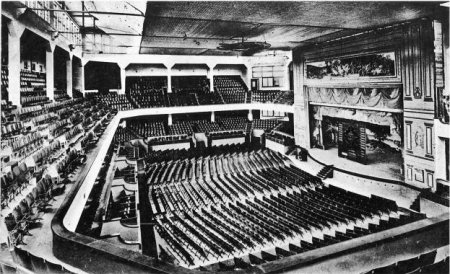
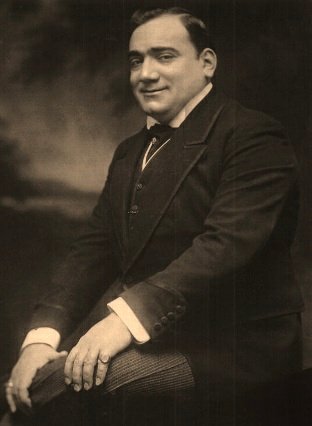
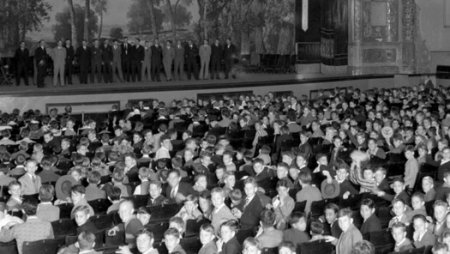
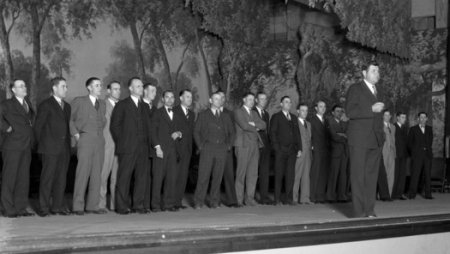
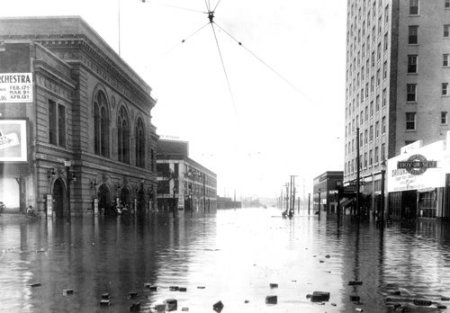
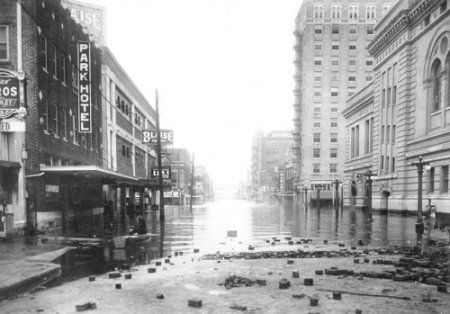

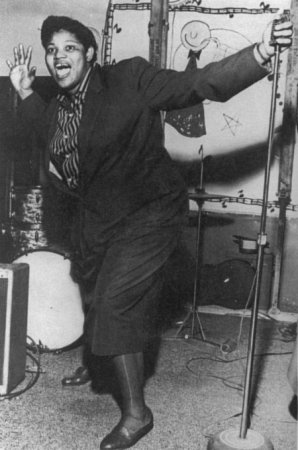


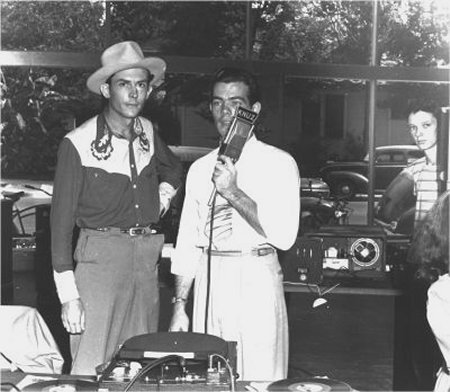
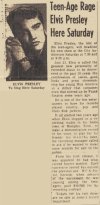 Now
headliners themselves, on April 21, 1956 they appeared at the Auditorium
for the last time. Ads for the shows ran in both the Houston Post and the
Chronicle. On Thursday, the 19th the Chronicle ran the following story:
Now
headliners themselves, on April 21, 1956 they appeared at the Auditorium
for the last time. Ads for the shows ran in both the Houston Post and the
Chronicle. On Thursday, the 19th the Chronicle ran the following story:
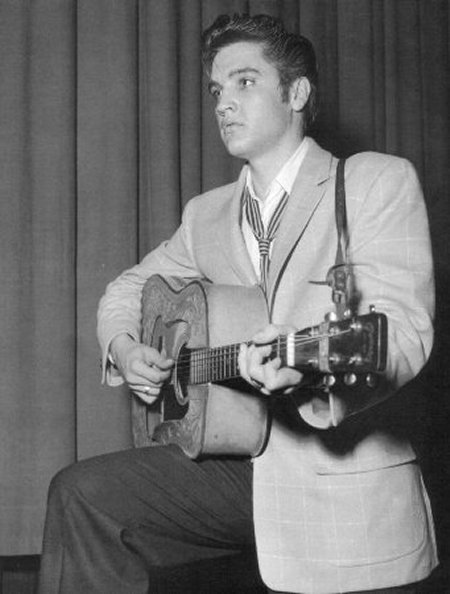
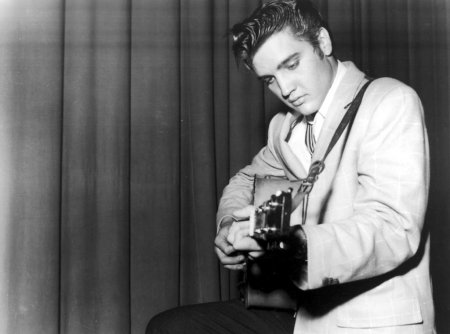



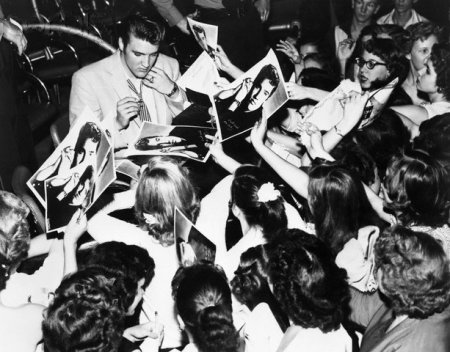
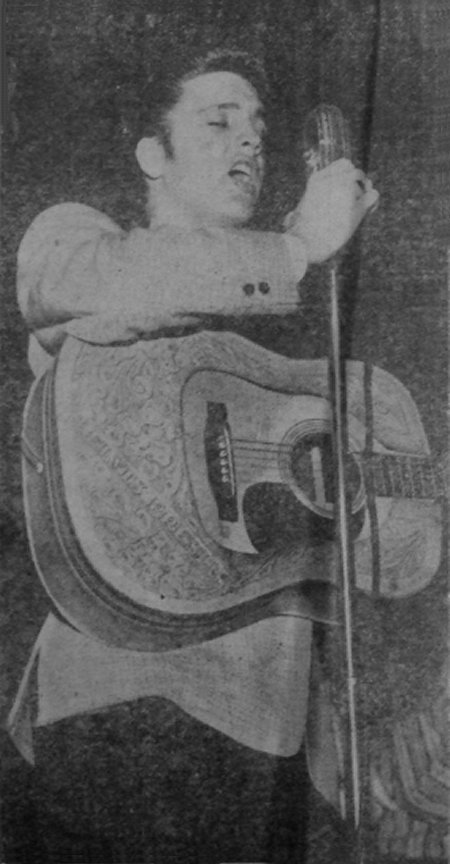
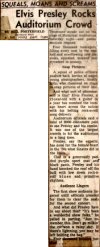 SQUEALS,
MOANS AND SCREAMS
SQUEALS,
MOANS AND SCREAMS